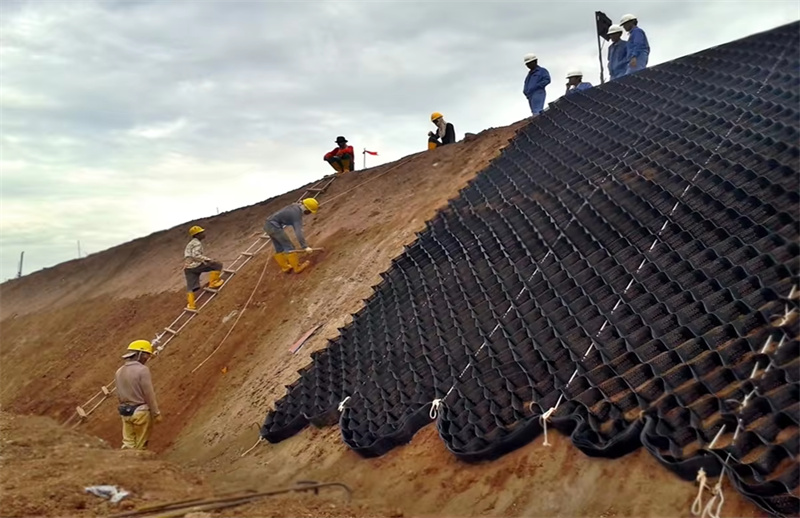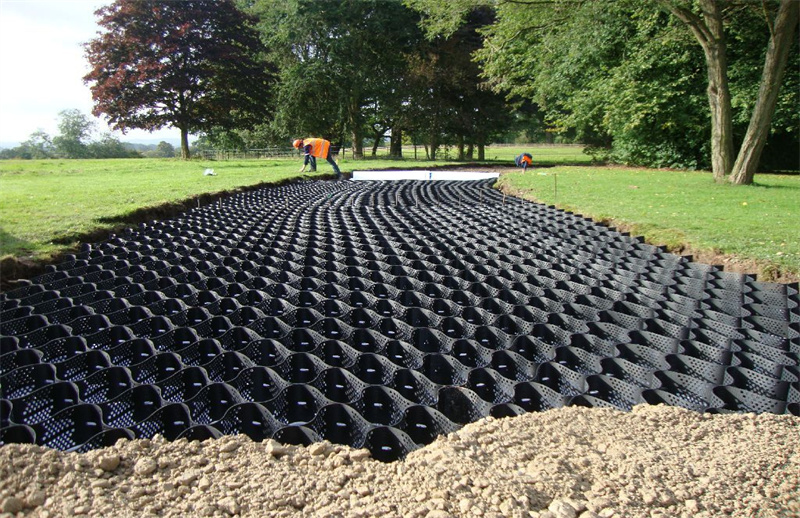Geocells offer a cost-effective, durable, and versatile solution for soil stabilization, improving load distribution, preventing erosion, and reducing material usage in a wide range of construction applications.



Product Name: HDPE Geocell
Cell Depth :50, 75, 100, 125, 150, 200mm
Weld Spacing: 330, 356, 400, 445, 660, 712mm
Thickness(Textured): 1.5, 1.52, 1.6mm
Thickness(Smooth): 1.1, 1.2mm
Colour: Black, Sandy, Green
Standard: ASTM, ISO
Geocells are a type of soil stabilization and reinforcement technology used in construction and civil engineering
Improved Load Distribution: Geocells help distribute loads more evenly across the soil, which can improve the stability of roads, foundations, and other structures.
Reduced Material Usage: By stabilizing the soil, geocells can reduce the need for additional fill materials, like gravel or sand, leading to cost savings and reduced environmental impact.
Enhanced Soil Strength: The confinement provided by geocells enhances the shear strength of the soil, preventing erosion and making it more resistant to deformation under heavy loads.
Erosion Control: Geocells can be used to prevent soil erosion, especially in areas with steep slopes or near water bodies, by creating a protective barrier that holds the soil in place.
Quick and Easy Installation: Geocells are relatively easy to install and can be deployed quickly, which can reduce project timelines.
Versatility: Geocells are used in a wide range of applications, including road construction, railways, slopes, landfills, and more.
Durability: Made from durable materials like high-density polyethylene (HDPE), geocells are resistant to UV degradation and can last for many years.
Cost-Effective: They offer a low-cost solution for soil reinforcement compared to traditional methods, like concrete or stone walls, especially in remote or challenging environments.
| Index Properties | Test Method | Units | Values | ||||||||||||
| Material | 100% Virgin HDPE | ||||||||||||||
| Carbon Black Content | ASTM D 1603 | % | ≥1.5 | ||||||||||||
| Density | ASTM D 1505 | g/cm3 | 0.935-0.965 | ||||||||||||
| Sheet Thickness +5% | ASTM D 5199 | mm | 1.5 | ||||||||||||
| Seam Peel Strength | USACE GL-86-19 | KN/m | ≥14.2 | ||||||||||||
| Tensile Strength at Yield | ASTM D 638 | KN/m | ≥22 | ||||||||||||
| Environmental Stress Crack Resistance ESCR | ASTM D 1693 | hrs | ≥5000 | ||||||||||||
| Oxidation Induction Time OlT | ASTM D 3895 | min | ≥150 | ||||||||||||
| Type No. | DK330 | DK356 | DK445 | DK660 | DK712 | ||||||||||
| Welding Distance(mm)3% | 330 | 356 | 445 | 660 | 712 | ||||||||||
| Cell Depth(mm)+3% | 50,75, 100,150,200,250 | ||||||||||||||
| Dimensions | |||||||||||||||
| Expanded Cell Size (widthxlength)(mm)+3% | 250×210 | 260 x225 | 320 x 288 | 470×450 | 510×475 | ||||||||||
| Expanded Cell Numbers (widthxlength) | 10×34 | 9 x 34 | 8 x 34 | 5 x34 | 5 x 34 | ||||||||||
| Expanded Section Size (widthxlength)(m)+3% | 2.50 x7.14 | 2.34 x 7.65 | 2.56 x 9.8 | 2.35 x 15.3 | 2.55 x 16.15 | ||||||||||
| Expanded Section Area (m2)+5% | 17.85 | 17.9 | 25.1 | 36 | 41.2 | ||||||||||
Geocells are versatile and adaptable, making them suitable for a wide variety of projects, from infrastructure development to environmental protection.
Roads and Pavements: Geocells are often used to stabilize subgrade soil in road construction, especially in areas with weak or expansive soils. They enhance the load-bearing capacity and reduce rutting or cracking in pavements.
Slope Stabilization: Geocells are used to prevent erosion and stabilize slopes, especially on steep terrains, by confining the soil and promoting vegetation growth. They are effective in protecting hillsides, embankments, and riverbanks.
Railway Tracks: Geocells are used to reinforce the foundation of railway tracks, improving the track’s stability and load distribution, while minimizing settlement or deformation over time.
Landfills and Waste Management: Geocells can be applied in landfill construction to stabilize the ground and improve drainage. They help with waste containment by providing a stable base for waste materials.
Retaining Walls: Geocells can be used to build cost-effective, environmentally friendly retaining walls that provide soil containment and prevent erosion, often used in landscape architecture or for slope protection.
Reinforced Foundations: In soft or unstable soils, geocells can act as a reinforcement layer beneath foundations to distribute loads more evenly, preventing settling or shifting of structures like buildings or bridges.
Flood Control and Riverbank Protection: Geocells are used to protect riverbanks, coastlines, and flood-prone areas from erosion. The geocell structure helps to prevent soil loss in areas impacted by water movement.
Airports and Military Applications: For heavy-duty applications, such as airport runways or military airfields, geocells provide additional strength and durability, enabling heavy vehicles to operate without damaging the surface.
Permeable Pavements: Geocells can be used in permeable pavement systems to allow water to flow through the surface, reducing runoff and promoting groundwater recharge.
Temporary Roads and Platforms: In construction sites or disaster relief operations, geocells can be quickly deployed to create temporary access roads or platforms for heavy machinery, without causing significant environmental impact.
Geocells offer a cost-effective, durable, and versatile solution for soil stabilization, improving load distribution, preventing erosion, and reducing material usage in a wide range of construction applications.


HDPE Geocell Installation Process
.
HDPE geocell installation process entails the following steps:
· Base Preparation– Prepare the site to use by eliminating all debris, vegetative cover, and any unnecessary soil from the area where the HDPE geocell will be placed. Replace the soil that is removed using materials that are accepted and complete any necessary earthwork.
· Deploy Hdpe Geocell– Locate the HDPE geocell section in the direction of the slope and ensure that the panels used suit the size of the slope. Anchor the top part of the HDPE geocell to the upper part of the slope and stretch it until it fits well.
· Infill Material- The material used for filling is chosen according to the soil properties and the needs of the project. You should fill the HDPE geocell with caution using a dump truck or front-end loader as the cells might be damaged by excess drop height.
Ensure that the infill material is just a little higher than the HDPE geocells to give room for compacting and settling. Finally, you should compact the HDPE geocell to suit the design desired for your project.
· Vegetation – Vegetation is used in the project to protect the topsoil from erosion due to rain. You can sow different types of grass to produce this vegetation system.
Advantages Of HDPE Geocell
· Cost Effective – HDPE Geocell cuts down the cost of onsite materials and decreases the structural layer thus cutting down on costs.
· Sustainable – It makes it possible for the reduction of nonrenewable resources by creating a surface that is vegetative and permeable.HDPE Geocells can reduce the carbon footprint.
· Fast Installation – HDPE Geocell is easy and quick to install as compared to other Geocell products thus saving time and reducing maintenance costs.
· Durable – It has a high tensile strength which increases its lifetime and ensures projects serve their purpose.
· Multi-Purpose – HDPE Geocell is used in a variety of ways such as reinforcement of slopes, stabilization of bases, and channel protection.
